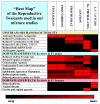Cumulative effects of in utero administration of mixtures of reproductive toxicants that disrupt common target tissues via diverse mechanisms of toxicity
- PMID: 20487044
- PMCID: PMC2874988
- DOI: 10.1111/j.1365-2605.2009.01049.x
Cumulative effects of in utero administration of mixtures of reproductive toxicants that disrupt common target tissues via diverse mechanisms of toxicity
Abstract
Although risk assessments are typically conducted on a chemical-by-chemical basis, the 1996 Food Quality Protection Act required the US Environmental Protection Agency to consider cumulative risk of chemicals that act via a common mechanism of toxicity. To this end, we are conducting studies with mixtures of chemicals to elucidate mechanisms of joint action at the systemic level with the goal of providing a framework for assessing the cumulative effects of reproductive toxicants. Previous mixture studies conducted with antiandrogenic chemicals are reviewed briefly and two new studies are described. In all binary mixture studies, rats were dosed during pregnancy with chemicals, singly or in pairs, at dosage levels equivalent to approximately one-half of the ED50 for hypospadias or epididymal agenesis. The binary mixtures included androgen receptor (AR) antagonists (vinclozolin plus procymidone), phthalate esters [di(n-butyl) phthalate (DBP) plus benzyl n-butyl phthalate (BBP) and diethyl hexyl phthalate (DEHP) plus DBP], a phthalate ester plus an AR antagonist (DBP plus procymidone), a mixed mechanism androgen signalling disruptor (linuron) plus BBP, and two chemicals which disrupt epididymal differentiation through entirely different toxicity pathways: DBP (AR pathway) plus 2,3,7,8 TCDD (AhR pathway). We also conducted multi-component mixture studies combining several 'antiandrogens'. In the first study, seven chemicals (four pesticides and three phthalates) that elicit antiandrogenic effects at two different sites in the androgen signalling pathway (i.e. AR antagonist or inhibition of androgen synthesis) were combined. In the second study, three additional phthalates were added to make a 10 chemical mixture. In both the binary mixture studies and the multi-component mixture studies, chemicals that targeted male reproductive tract development displayed cumulative effects that exceeded predictions based on a response-addition model and most often were in accordance with predictions based on dose-addition models. In summary, our results indicate that compounds that act by disparate mechanisms of toxicity to disrupt the dynamic interactions among the interconnected signalling pathways in differentiating tissues produce cumulative dose-additive effects, regardless of the mechanism or mode of action of the individual mixture component.
Figures






Similar articles
-
Cumulative effects of in utero administration of mixtures of "antiandrogens" on male rat reproductive development.Toxicol Pathol. 2009 Jan;37(1):100-13. doi: 10.1177/0192623308329478. Epub 2009 Jan 15. Toxicol Pathol. 2009. PMID: 19147833 Review.
-
Administration of potentially antiandrogenic pesticides (procymidone, linuron, iprodione, chlozolinate, p,p'-DDE, and ketoconazole) and toxic substances (dibutyl- and diethylhexyl phthalate, PCB 169, and ethane dimethane sulphonate) during sexual differentiation produces diverse profiles of reproductive malformations in the male rat.Toxicol Ind Health. 1999 Jan-Mar;15(1-2):94-118. doi: 10.1177/074823379901500109. Toxicol Ind Health. 1999. PMID: 10188194
-
A mixture of seven antiandrogens induces reproductive malformations in rats.Int J Androl. 2008 Apr;31(2):249-62. doi: 10.1111/j.1365-2605.2007.00859.x. Epub 2008 Jan 16. Int J Androl. 2008. PMID: 18205796
-
Perinatal exposure to the phthalates DEHP, BBP, and DINP, but not DEP, DMP, or DOTP, alters sexual differentiation of the male rat.Toxicol Sci. 2000 Dec;58(2):350-65. doi: 10.1093/toxsci/58.2.350. Toxicol Sci. 2000. PMID: 11099647
-
Reproductive and developmental toxicity of phthalates.J Toxicol Environ Health B Crit Rev. 2009 Apr;12(4):225-49. doi: 10.1080/10937400903094091. J Toxicol Environ Health B Crit Rev. 2009. PMID: 20183522 Review.
Cited by
-
Food components and contaminants as (anti)androgenic molecules.Genes Nutr. 2017 Feb 16;12:6. doi: 10.1186/s12263-017-0555-5. eCollection 2017. Genes Nutr. 2017. PMID: 28239427 Free PMC article. Review.
-
EDC-2: The Endocrine Society's Second Scientific Statement on Endocrine-Disrupting Chemicals.Endocr Rev. 2015 Dec;36(6):E1-E150. doi: 10.1210/er.2015-1010. Epub 2015 Nov 6. Endocr Rev. 2015. PMID: 26544531 Free PMC article. Review.
-
Cumulative maternal and neonatal effects of combined exposure to a mixture of perfluorooctanoic acid (PFOA) and perfluorooctane sulfonic acid (PFOS) during pregnancy in the Sprague-Dawley rat.Environ Int. 2022 Dec;170:107631. doi: 10.1016/j.envint.2022.107631. Epub 2022 Nov 12. Environ Int. 2022. PMID: 36402036 Free PMC article.
-
Estimated Daily Intake and Cumulative Risk Assessment of Phthalates in the General Taiwanese after the 2011 DEHP Food Scandal.Sci Rep. 2017 Mar 22;7:45009. doi: 10.1038/srep45009. Sci Rep. 2017. PMID: 28327585 Free PMC article.
-
Windows of sensitivity to toxic chemicals in the development of reproductive effects: an analysis of ATSDR's toxicological profile database.Int J Environ Health Res. 2018 Oct;28(5):553-578. doi: 10.1080/09603123.2018.1496235. Epub 2018 Jul 19. Int J Environ Health Res. 2018. PMID: 30022686 Free PMC article.
References
-
- Akingbemi BT, Sottas CM, Koulova AI, Klinefelter GR, Hardy MP. Inhibition of testicular steroidogenesis by the xenoestrogen bisphenol A is associated with reduced pituitary luteinizing hormone secretion and decreased steroidogenic enzyme gene expression in rat Leydig cells. Endocrinology. 2004;145:592–603. - PubMed
-
- Altenburger R, Backhaus T, Boedeker W, Faust M, Scholze M, Grimme LH. Predictability of the toxicity of multiple chemical mixtures to Vibrio fischeri: Mixtures composed of similarly acting chemicals. Environmental Toxicology and Chemistry. 2000;19:2341–2347.
-
- Altenburger R, Schmitt H, Schuurmann G. Algal toxicity of nitrobenzenes: Combined effect analysis as a pharmacological probe for similar modes of interaction. Environmental Toxicology and Chemistry. 2005;24:324–333. - PubMed
-
- Ankley GT, Brooks BW, Huggett DB, Sumpter JP. Repeating History: pharmaceuticals in the environment. Environmental science & technology. 2007;41:8211–8217. - PubMed
-
- Backhaus T, Scholze M, Grimme LH. The single substance and mixture toxicity of quinolones to the bioluminescent bacterium Vibrio fischeri. Aquatic toxicology (Amsterdam, Netherlands) 2000;49:49–61. - PubMed
Publication types
MeSH terms
Substances
Grants and funding
LinkOut - more resources
Full Text Sources
Research Materials

